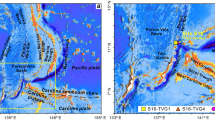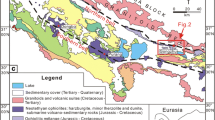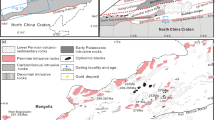Abstract
Petrographic and geochemical studies of peridotites from the South Sandwich forearc region provide new evidence for the evolution of the South Sandwich arc–basin system and for the nature of interactions between arc magma and oceanic lithosphere. Peridotites from the inner trench wall in the north-east corner of the forearc vary from clinopyroxene-bearing harzburgites, through samples transitional between harzburgites and dunites or wehrlites, to dunites. The harzburgites are LREE depleted with low incompatible element abundances and have chromites with intermediate Cr# (ca. 0.40). Modelling shows that they represent the residues from 15–20% melting at oxygen fugacities close to the QFM buffer. The dunites have U-shaped REE patterns, low incompatible element abundances and high Cr# (0.66–0.77). Petrography and geochemistry indicate that the latter are the product of intense interaction between peridotite and melt saturated with olivine under conditions of high oxygen fugacity (QFM + 2). The transitional samples are the product of lesser interaction between peridotite and melt saturated with olivine ± clinopyroxene. The data demonstrate that the harzburgites originated as the residue from melting at a ridge (probably the early East Scotia Sea spreading centre), and were subsequently modified to transitional peridotites and dunites by interaction with South Sandwich arc magmas. The second dredge locality, near the South Sandwich Trench–Fracture Zone intersection, yielded rocks ranging from lherzolite to harzburgite that could similarly have resulted from a two-stage melting and enrichment process, but involving a more fertile mantle residue and a reacting melt that is transitional between MORB and island arc tholeiite. The South Sandwich peridotites have a similar petrogenetic history to those from Conical Seamount in the Mariana forearc in the sense that both involved interaction between arc magma and pre-existing mantle lithosphere of different provenance. However, the precise compositions of the magma and mantle components vary from location to location according to the precise tectonic setting and tectonic history. Overall, therefore, data from the South Sandwich and Izu–Bonin–Mariana systems emphasise the potential significance of peridotite geochemistry in unravelling the complex tectonic histories of forearcs past and present.
Similar content being viewed by others
Author information
Authors and Affiliations
Additional information
Received: 31 August 1999 / Accepted: 3 December 1999
Rights and permissions
About this article
Cite this article
Pearce, J., Barker, P., Edwards, S. et al. Geochemistry and tectonic significance of peridotites from the South Sandwich arc–basin system, South Atlantic. Contrib Mineral Petrol 139, 36–53 (2000). https://doi.org/10.1007/s004100050572
Issue Date:
DOI: https://doi.org/10.1007/s004100050572




